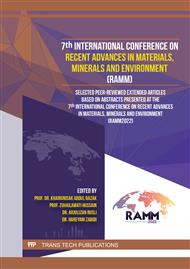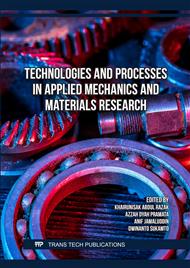[1]
M. of H. Malaysia, "COVID-19 Deaths in Malaysia," 2022. [Online]. Available: https://covidnow.moh.gov.my/deaths/. [Accessed: 12-Jul-2022].
Google Scholar
[2]
D. Gatherer, "The 2014 Ebola virus disease outbreak in West Africa," J. Gen. Virol., vol. 95, no. PART 8, p.1619–1624, 2014.
DOI: 10.1099/vir.0.067199-0
Google Scholar
[3]
A. C. Sun and D. A. Hall, "Point-of-Care Smartphone-based Electrochemical Biosensing," Electroanalysis, vol. 31, no. 1, p.2–16, 2019.
DOI: 10.1002/elan.201800474
Google Scholar
[4]
S. I. Kaya, L. Karadurmus, G. Ozcelikay, N. K. Bakirhan, and S. A. Ozkan, "Electrochemical virus detections with nanobiosensors," Nanosensors for Smart Cities, p.303–326, 2020.
DOI: 10.1016/B978-0-12-819870-4.00017-7
Google Scholar
[5]
T. Ozer, B. J. Geiss, and C. S. Henry, "Review—Chemical and Biological Sensors for Viral Detection," J. Electrochem. Soc., vol. 167, no. 3, p.037523, 2020.
DOI: 10.1149/2.0232003jes
Google Scholar
[6]
R. Lu et al., "Genomic characterisation and epidemiology of 2019 novel coronavirus: implications for virus origins and receptor binding.," Lancet (London, England), vol. 395, no. 10224, p.565–574, Jan. 2020.
Google Scholar
[7]
H. A. Rothan and S. N. Byrareddy, "The epidemiology and pathogenesis of coronavirus disease (COVID-19) outbreak," J. Autoimmun., vol. 109, p.102433, 2020.
DOI: 10.1016/j.jaut.2020.102433
Google Scholar
[8]
U. of O. Oxford Martin School, "COVID-19 Data Explorer," 2022. [Online]. Available: https://ourworldindata.org/explorers/coronavirus-data-explorer.
Google Scholar
[9]
L. Zeng, X. Tao, W. Yuan, J. Wang, X. Liu, and Z. Liu, "First case of neonate infected with novel coronavirus pneumonia in China," Zhonghua Er Ke Za Zhi., vol. 58, p. E009, Feb. 2020.
Google Scholar
[10]
C. Eastin and T. E. Ms, "Clinical Characteristics of Coronavirus Disease 2019 in China," J. Emerg. Med., vol. 58, no. 4, p.711–712.
DOI: 10.1016/j.jemermed.2020.04.004
Google Scholar
[11]
C. Lu, X. Liu, and Z. Jia, "surface must not be," Lancet, vol. 395, no. 10224, p. e39, 2020.
DOI: 10.1016/S0140-6736(20)30313-5
Google Scholar
[12]
P. A. Rota et al., "Characterization of a Novel," vol. 1394, no. 2003, 2014.
DOI: 10.1126/science.1085952
Google Scholar
[13]
J. Shang et al., "Structural basis of receptor recognition by," Nature, vol. 581, no. February, 2020.
DOI: 10.1038/s41586-020-2179-y
Google Scholar
[14]
I. D. A. Santos et al., "Antivirals Against Coronaviruses : Candidate Drugs for SARS-CoV-2 Treatment ?," vol. 11, no. August, 2020.
DOI: 10.3389/fmicb.2020.01818
Google Scholar
[15]
N. T. P. Mishra et al., "Global impacts of pre- and post-COVID-19 pandemic: Focus on socio-economic consequences," Sensors Int., vol. 1, p.100042, 2020.
DOI: 10.1016/j.sintl.2020.100042
Google Scholar
[16]
J. W. Law, N. A. Mutalib, K. Chan, and L. Lee, "Rapid methods for the detection of foodborne bacterial pathogens : principles , applications , advantages and limitations," vol. 5, no. January, p.1–19, 2015.
DOI: 10.3389/fmicb.2014.00770
Google Scholar
[17]
D. Wu, T. Wu, Q. Liu, and Z. Yang, "International Journal of Infectious Diseases The SARS-CoV-2 outbreak : What we know," vol. 94, p.44–48, 2020.
DOI: 10.1016/j.ijid.2020.03.004
Google Scholar
[18]
B. Udugama et al., "Diagnosing COVID-19: The Disease and Tools for Detection," ACS Nano, vol. 14, no. 4, p.3822–3835, Apr. 2020.
DOI: 10.1021/acsnano.0c02624
Google Scholar
[19]
J. N. Kanji et al., "False negative rate of COVID-19 PCR testing: a discordant testing analysis," Virol. J., vol. 18, no. 1, p.13, 2021.
DOI: 10.1186/s12985-021-01489-0
Google Scholar
[20]
A. Tang, Y. Xin, C. Gao, L. Zhu, Y. Jie, and S. Zhang, "Dynamic pro fi le of RT-PCR fi ndings from 301 COVID-19 patients in Wuhan , China : A descriptive study," vol. 127, no. March, p.0–6, 2020.
DOI: 10.1016/j.jcv.2020.104346
Google Scholar
[21]
K. M. Koczula and A. Gallotta, "Lateral flow assays," no. June, p.111–120, 2016.
DOI: 10.1042/EBC20150012
Google Scholar
[22]
F. A. Alhajj M, "Enzyme Linked Immunosorbent Assay," in Enzyme Linked Immunosorbent Assay, 2022.
DOI: 10.1007/springerreference_32157
Google Scholar
[23]
L. Alanagreh, F. Alzoughool, and M. Atoum, "The Human Coronavirus Disease COVID-19: Its Origin, Characteristics, and Insights into Potential Drugs and Its Mechanisms," Pathogens , vol. 9, no. 5. 2020.
DOI: 10.3390/pathogens9050331
Google Scholar
[24]
S. Iravani, "Materials Advances SARS-CoV-2 : challenges and opportunities," p.3092–3103, 2020.
DOI: 10.1039/d0ma00702a
Google Scholar
[25]
K. J. Land, D. I. Boeras, X. Chen, A. R. Ramsay, and R. W. Peeling, "control strategies , strengthen health systems and improve patient outcomes," Nat. Microbiol., vol. 4, no. January, 2019.
DOI: 10.1038/s41564-018-0295-3
Google Scholar
[26]
D. R. Thévenot, K. Toth, R. A. Durst, and G. S. Wilson, "Electrochemical biosensors: recommended definitions and classification.," England, Jan. 2001.
Google Scholar
[27]
O. B. Daramola, N. Torimiro, T. O. Fadare, and R. K. Omole, "Functionalized Inorganic Nanoparticles for the Detection of Food and Waterborne Bacterial Pathogens," vol. 6, no. 1, p.1–14, 2020.
DOI: 10.12691/nnr-6-1-1
Google Scholar
[28]
S. Sadat, S. Elizabeth, and S. Mahshid, "Biosensors and Bioelectronics The potential application of electrochemical biosensors in the COVID-19 pandemic : A perspective on the rapid diagnostics of SARS-CoV-2," Biosens. Bioelectron., vol. 176, no. December 2020, p.112905, 2021.
DOI: 10.1016/j.bios.2020.112905
Google Scholar
[29]
S. Iravani, "Nano- and biosensors for the detection of SARS-CoV-2: challenges and opportunities," Mater. Adv., vol. 1, no. 9, p.3092–3103, 2020.
DOI: 10.1039/D0MA00702A
Google Scholar
[30]
S. Mahari, A. Roberts, D. Shahdeo, and S. Gandhi, "eCovSens-Ultrasensitive Novel In-House Built Printed Circuit Board Based Electrochemical Device for Rapid Detection of nCovid-19 eCovSens-Ultrasensitive Novel In-House Built Printed Circuit Board Based Electrochemical Device for Rapid Detection of nCovid-19," no. April, 2020.
DOI: 10.1101/2020.04.24.059204
Google Scholar
[31]
J. Tian, D. Sun, and Z. Chen, "Electrochimica Acta An electrochemical dual-aptamer biosensor based on metal-organic frameworks MIL-53 decorated with Au @ Pt nanoparticles and enzymes for detection of COVID-19 nucleocapsid protein," vol. 387, 2021.
DOI: 10.1016/j.electacta.2021.138553
Google Scholar
[32]
O. Sadak, F. Sadak, O. Yildirim, and N. M. Iverson, "Electrochemical Biosensing and Deep Learning-Based Approaches in the Diagnosis of COVID-19 : A Review," vol. 10, no. June, 2022.
DOI: 10.1109/access.2022.3207207
Google Scholar
[33]
I. Cho, D. H. Kim, and S. Park, "Electrochemical biosensors : perspective on functional nanomaterials for on-site analysis," p.1–12, 2020.
Google Scholar
[34]
C. Kokkinos, "Electrochemical DNA Biosensors Based on Labeling with Nanoparticles," p.12–16, 2019.
Google Scholar
[35]
"Optical Fiber Sensors for Rapid Screening of COVID‑19.pdf." .
Google Scholar
[36]
D. Murugan, H. Bhatia, and V. V. R. S. Jitendra, "P ‑ FAB : A Fiber ‑ Optic Biosensor Device for Rapid Detection of COVID ‑ 19," Trans. Indian Natl. Acad. Eng., vol. 5, no. 2, p.211–215, 2020.
DOI: 10.1007/s41403-020-00122-w
Google Scholar
[37]
T. Applications, "Overview of Piezoelectric Biosensors, Immunosensors and DNA Sensors and Their Applications," 2018.
DOI: 10.3390/ma11030448
Google Scholar
[38]
C. Huang et al., "Articles Clinical features of patients infected with 2019 novel coronavirus in Wuhan , China," p.497–506, 2020.
DOI: 10.1016/S0140-6736(20)30183-5
Google Scholar
[39]
B. Zuo, S. Li, Z. Guo, J. Zhang, and C. Chen, "Piezoelectric Immunosensor for SARS-Associated Coronavirus in Sputum," vol. 76, no. 13, p.3536–3540, 2004.
DOI: 10.1021/ac035367b
Google Scholar
[40]
J. Pietschmann, "Brief Communication : Magnetic Immuno-Detection of SARS-CoV-2 specific Antibodies Brief Communication : Magnetic Immuno-Detection of SARS-CoV-2 specific Antibodies," no. June, 2020.
DOI: 10.1101/2020.06.02.131102
Google Scholar
[41]
K. Wu, R. Saha, D. Su, and V. Dk, "Magnetic Immunoassays : A Review of Virus and Pathogen Detection Before and Amidst the Coronavirus Disease-19 ( COVID-19 )," vol. 19, no. July, 2020.
Google Scholar
[42]
F. Narita et al., "A Review of Piezoelectric and Magnetostrictive Biosensor Materials for Detection of COVID-19 and Other Viruses," vol. 2005448, 2021.
DOI: 10.1002/adma.202005448
Google Scholar
[43]
H. Zhao et al., "Sensors and Actuators : B . Chemical Ultrasensitive supersandwich-type electrochemical sensor for SARS-CoV-2 from the infected COVID-19 patients using a smartphone," Sensors Actuators B. Chem., vol. 327, no. September 2020, p.128899, 2021.
DOI: 10.1016/j.snb.2020.128899
Google Scholar
[44]
A. Ali et al., "Sensing of COVID-19 Antibodies in Seconds via Aerosol Jet Nanoprinted Reduced-Graphene-Oxide-Coated 3D Electrodes," vol. 2006647, p.1–15, 2021.
DOI: 10.1002/adma.202006647
Google Scholar
[45]
A. Raziq, A. Kidakova, R. Boroznjak, J. Reut, A. Opik, and V. Syritski, "Biosensors and Bioelectronics Development of a portable MIP-based electrochemical sensor for detection of SARS-CoV-2 antigen," vol. 178, no. January, 2021.
DOI: 10.1016/j.bios.2021.113029
Google Scholar
[46]
J. C. Huang et al., "Biosensors and Bioelectronics Detection of severe acute respiratory syndrome ( SARS ) coronavirus nucleocapsid protein in human serum using a localized surface plasmon coupled fluorescence fiber-optic biosensor," vol. 25, p.320–325, 2009.
DOI: 10.1016/j.bios.2009.07.012
Google Scholar
[47]
B. A. Taha et al., "An Analysis Review of Detection Coronavirus Biosensor Application," vol. 2019, p.1–29, 2020.
Google Scholar
[48]
F. A. Laura Fabiani, Marco Saroglia, Giuseppe Galata, Riccardo De Santis, Silvia Fillo, Vincenzo Luca, Giovanni Faggioni, Nino D'Amore, Elisa Regalbuto, Piero Salvatori, Genciana Terova, Danila Moscone, Florigio Lista, "Magnetic beads combined with carbon black-based screen-printed electrodes for COVID-19: A reliable and miniaturized electrochemical immunosensor for SARS-CoV-2 detection in saliva." Elsevier B.V., 2020.
DOI: 10.1016/j.bios.2020.112686
Google Scholar



